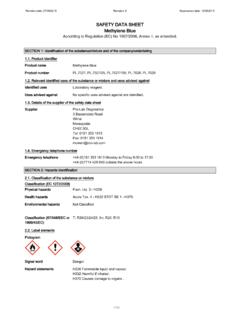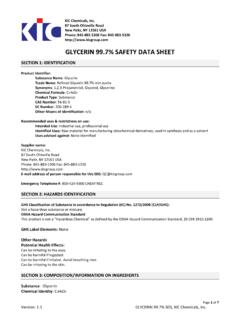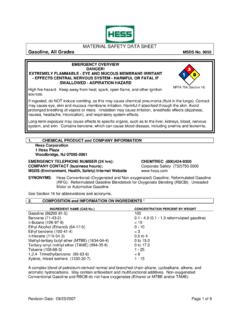Transcription of SAFETY DATA SHEET No. 2 Fuel Oil
1 SAFETY DATA SHEET No. 2 Fuel Oil 1. IDENTIFICATIONP roduct Identifier Synonyms: Intended use of the product: Contact: Contact Information: No. 2 Fuel Oil No. 2 Heating Oil, #2 Fuel Oil, Heating Oil Plus , Low Sulfur Heating Oil (LSHO), Ultra Low Sulfur Heating Oil (ULSHO) Fuel Bottini Fuel 2785 West Main St Wappingers Falls, NY EMERGENCY TELEPHONE NUMBER (24 hrs.): CHEMTREC (800) 424-9300 COMPANY CONTACT (business hours): 845-297-5580 IDENTIFICATIONA ccording to OSHA 29 CFR HCS Classification of the Substance or Mixture Classification (GHS-US): Flam. Liquid Category 3 H226 Skin Corrosion/Irritation Category 2 H315 Aspiration Hazard Category 1 H304 Acute toxicity Inhalation Category 4 H332 STOT SE Category 3 H336 Carcinogenicity Category 2H350 Aquatic Chronic Category 2 H411 Eye damage/Irritation Category 2 H319 Labeling Elements Signal Word (GHS-US): Danger Hazard Statements (GHS-US): H226 Flammable liquid and vapor.
2 H315 Causes Skin irritation. H304 May be fatal if swallowed and enters airways. H332 Harmful if inhaled. H336 May cause drowsiness or dizziness. H350 May cause cancer. H411 Toxic to aquatic life with long lasting effects. H319 May cause eye damage/irritation. Precautionary Statements (GHS-US): P210 - Keep away from heat/sparks/open flames/hot surfaces. - No smoking. P233 - Keep container tightly closed. P240 Ground/bond container and receiving equipment. Page 1 of 11 April 2018 SAFETY DATA SHEET No. 2 Fuel Oil P241 Use explosion-proof electrical/ventilating/lighting equipment pursuant to applicable electrical code. P242 Use only non-sparking tools.
3 P243 Take precautionary measures against static discharge. P261 Avoid breathing dust/fume/gas/mist/vapors/spray. P264 Wash skin thoroughly after handling. P271 Use only outdoors or in a well-ventilated area. P273 Avoid release to the environment. P280 - Wear protective gloves/protective clothing/eye protection/face protection. P303+361+353 - If on skin (or hair): Take off immediately all contaminated clothing. Rinse with water/shower. P308+311 - If exposed or concerned: Get medical advice/attention. P301+310 - If swallowed: Immediately call a poison center/doctor/.. P331 - Do NOT induce vomiting. P370+P378 In case of fire use firefighting foam or other appropriate media for Class B fires to extinguish.
4 P403+235 - Store in a well-ventilated place. Keep cool. P405 - Store locked up. P501 Dispose of contents/container in accordance with local/regional/national/international regulation. Other information: NFPA 704 Health: 1 Fire: 2 Reactivity: 0 / INFORMATION ON INGREDIENTSC hemical Composition Information Mixture Name Product Identifier (CAS#) % (w/w) Classification No. 2 Fuel Oil 68476-30-2 95-100 Flam Liq. 3, H226; Skin Irrit. 2, H315; Aspiration 1, H304; STOT SE 3, H336; H350; Aquatic chronic 2, H411 Methyl Esters N/A 0-5N/A Naphthalene Carc. 2, H351; Acute Tox. 4, H302; Aquatic Acute 1, H400; Aquatic Chronic 1, H411 Additional Formulation Information: No.
5 2 Fuel Oil consists of C9+ hydrocarbons resulting from distillation of crude oil. Low Sulfur Heating Oil typically contains less than 500 ppm of sulfur Ultra Low Sulfur Heating Oil typically contains less than 15 ppm of sulfur Page 2 of 11 April 2018 SAFETY DATA SHEET No. 2 Fuel Oil AID MEASURESR oute Measures Inhalation Remove person to fresh air. If person is not breathing, ensure an open airway and provide artificial respiration. If necessary, provide additional oxygen once breathing is restored if trained to do so. Seek medical attention immediately. Ingestion Aspiration Hazard: DO NOT INDUCE VOMITING. Do not give liquids. Obtain immediate medical attention.
6 If spontaneous vomiting occurs, lean victim forward to reduce the risk of aspiration. Ingestion may cause gastrointestinal disturbances including irritation, nausea, vomiting, and diarrhea, and central nervous system (brain) effects similar to alcohol intoxication. In severe cases, tremors, convulsions, loss of consciousness, coma, respiratory failure, and death. Eye Contact In case of contact with eyes, immediately flush with clean, low-pressure water for at least 15 min. Hold eyelids open to ensure adequate flushing. Seek medical attention. In case of contact lenses, remove immediately. Skin Contact Remove contaminated clothing and shoes. Wash contaminated areas thoroughly with soap and water or waterless hand cleanser.
7 Obtain medical attention if irritation or redness develops. Thermal burns require immediate medical attention depending on the severity and of the area of the body burned. Most Important Symptoms Contact with eyes and face may cause irritation. Long-term exposure may cause dermatitis (itching, irritation, pain and swelling). Inhalation may cause irritation and significant or long term exposure could cause respiratory insufficiency and pulmonary edema. Ingestion may cause aspiration, gastrointestinal disturbance, and CNS effects. Immediate Medical Attention and Special Treatment For contact with skin or eyes, immediately wash or flush contaminated eyes with gently flowing water.
8 If possible, irrigate each eye continuously with saline (NS). If ingested, rinse mouth. Do NOT induce vomiting, as this may cause chemical pneumonia (fluid in the lungs). If inhaled, administer oxygen or establish a patent airway if breathing is labored. Suction if necessary. Monitor closely, anticipate seizures. Consider orotracheal or nostracheal intubation of airway control if patient is unconscious or is in severe respiratory distress. Discard any clothing or shoes contaminated as they may be flammable. 5. FIRE-FIGHTING MEASURESE xtinguishing Media Foam, carbon dioxide, dry chemical are most suitable SMALL FIRES: Any extinguisher suitable for Class B fires, dry chemical, C02, water spray, firefighting foam, or Halon.
9 Small fires in the incipient (beginning) stage may typically be extinguished using handheld portable fire extinguishers and other firefighting FIRES: Foam, carbon dioxide, dry chemical. Water may be ineffective for fighting the fire, but may be used to cool fire-exposed containers. Specific Hazards / Products of Combustion Moderate fire hazard when exposed to heat or flame with a very low flash point. Product is flammable and easily ignited when exposed to heat, spark, open flame or other source of ignition. Flowing product may be ignited by self-generated static electricity. When mixed with air and exposed to an ignition source, flammable vapors can burn in the open or explode in confined spaces.
10 Being heavier than air, vapors may travel long distances to an ignition source and flash back. Runoff to sewer may cause fire or explosion hazard. Combustion may produce smoke, carbon monoxide and other products of incomplete combustion. Special precautions and Protective Equipment for Firefighters Isolate area around container involved in fire. Cool tanks, shells, and containers exposed to fire and excessive heat with water. Page 3 of 11 April 2018 SAFETY DATA SHEET No. 2 Fuel Oil For massive fires the use of unmanned hose holders or monitor nozzles may be advantageous to further minimize personnel exposure. Major fires may require withdrawal, allowing the tank to burn.








